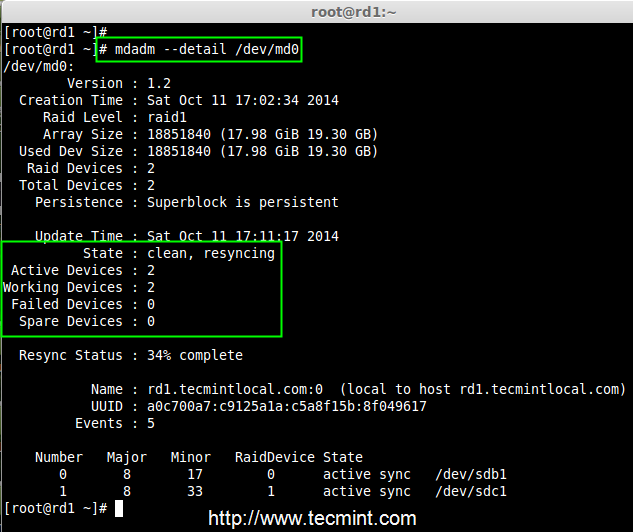
Use this command to display the log entries. Use this command to display information about the existing hard disks.Īrcconf getlogscontroller-number device ¦ dead ¦ event This command displays information about the RAID controller, configuration, RAID arrays, available disks and their current state. Use the following commands to view detailed information about the Adaptec RAID controller and configuration: To fix your broken Raid1’s on your Intel raid’s, use “dmraid -R ” and watch “dmsetup status” and wait for the ratio to be 1.The Adaptec RAID controller is managed with the arcconf command line tool. Consequently, i yanked the good 80gb drive from this set, and plugged in a 750gb Seagate, and was able to mirror back to that without a problem. It didn’t work with another Seagate drive, but it worked with a different drive.

dev/sda: isw, "isw_djhffiddde", GROUP, ok, 72303838 sectors, ~]# dmraid -s Isw_djhffiddde_Systemp2: 0 41720805 linear I also found a command to monitor this progress. On top of that, i could hear the grumblings of the WD, and i could see LED activity. Now, i added the new WDRaptor to this ~]# dmraid -R isw_djhffiddde_System /dev/sdb Booted up, and dmraid still showed the same stuff, inconsistent raid set. To figure out if its doing something, i turned the machine off and removed the new drive, and put in a Western Digital Raptor. I should look at the source code, but i cant be bothered.Īlright, so it appears that its not working. Ok, so its not inconsistent now, but it is “nosync”, which i cannot figure out what it means. I cant really hear any grumblings from the drive, nor can i see the LED’s flash. dmraid thinks its working, but i cant see it. What’s happened? To be honest, I’ll never know – but it seems like it was not working. RAID set "isw_djhffiddde_System" already activeĭevice "isw_djhffiddde_System" is now registered with dmeventd for monitoring So, here ~]# dmraid -R isw_djhffiddde_System /dev/sdb According to the man pages, and the Google, to repair it you use “dmraid -R /dev/” That’s what i want to see when a disk fails in my raid sets. So, dmraid tells me that the raid is broken and inconsistent. After fiddling with the bios for a few minutes (my machine wanted to boot form the newly installed drive, not the raid) i got back in, and this is what i ~]# dmraid -sĮRROR: isw: wrong number of devices in RAID set "isw_djhffiddde_System" on /dev/sda I then, turned the machine off, and yanked a drive, inserted a different drive, and turned it back on. This tells me, my mirror set is running, and has two drives attached and all is happy. Then running “dmraid -r” gave ~]# dmraid -r The first thing i did, was find out what i’ve got. I then installed CentOS 5.5 32bit on this machine, and went to work. I booted up the machine, went into the Intel raid setup, and created a 20gb mirror partition called “System”. My test setup was a simple ICH6R machine with two 160gb Seagate hard drives. What *you* may find is that your implementation is different, but this posting should help you. Intel is the most common one, and that’s the one i generally have on all my Intel servers. Your raid can be from Intel, Nvidia, Promise and a few others who do implement it. Sort ofĭMRaid is the linux implementation of popular onboard RAID setups. So i spent a whole afternoon figuring this out. But that didn’t work in my test environments. But how do you do this on a Linux server which has no Storage Matrix software? After hours of Googling, i came across the command “dmraid -R”.

Raid monitor linux software#
On Windows, this is simple, you launch the Storage Matrix software and click rebuild (if it isn’t rebuilding automagically). What do i do when (and they will) a drive fails? How does ISW handle it? But something has always really bugged me.
Raid monitor linux windows#
For many years this has worked absolutely perfectly with no issues on both Windows and Linux. For years, I’ve ran many small servers running the popular ICH/ISW Intel Storage Matrix RAID in Raid-1 configuration.


 0 kommentar(er)
0 kommentar(er)
